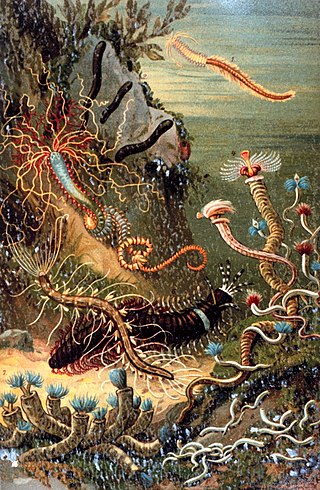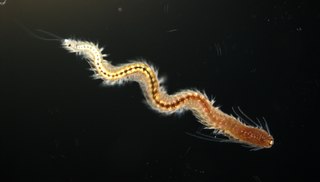
Polychaeta is a paraphyletic class of generally marine annelid worms, commonly called bristle worms or polychaetes. Each body segment has a pair of fleshy protrusions called parapodia that bear many bristles, called chaetae, which are made of chitin. More than 10,000 species are described in this class. Common representatives include the lugworm and the sandworm or clam worm Alitta.

Spirobranchus giganteus, commonly known as the Christmas tree worm, is a tube-building polychaete worm belonging to the family Serpulidae. The S. giganteus lives in coral reefs in the Indo-Pacific region to the Caribbean.

Chaetopterus or the parchment worm or parchment tube worm is a genus of marine polychaete worm that lives in a tube it constructs in sediments or attaches to a rocky or coral reef substrate. The common name arises from the parchment-like appearance of the tubes that house these worms. Parchment tube worms are filter feeders and spend their adult lives in their tubes, unless the tube is damaged or destroyed. They are planktonic in their juvenile forms, as is typical for polychaete annelids. Species include the recently discovered deep water Chaetopterus pugaporcinus and the well-studied Chaetopterus variopedatus.

Alitta succinea is a species of marine annelid in the family Nereididae. It has been recorded throughout the North West Atlantic, as well as in the Gulf of Maine and South Africa.

Hydroides norvegica is a species of tube-forming annelid worm in the family Serpulidae. It is found on submerged rocks, shells, piles and boats in many coastal areas around the world. It is the type species of the genus Hydroides.

Spirorbis borealis is a sedentary marine polychaete worm in the Serpulidae family. It is commonly called the sinistral spiral tubeworm and is the type species of the genus Spirorbis.

Sabellastarte spectabilis is a species of benthic marine polychaete worm in the Sabellidae family. It is commonly known as the feather duster worm, feather duster or fan worm. It is native to tropical waters of the Indo-Pacific but has spread to other parts of the world. It is popular in aquariums because of its distinctive appearance and its ability to remove organic particles and improve water quality.

Chaetopterus variopedatus is a species of parchment worm, a marine polychaete in the family Chaetopteridae. It is found worldwide. However, recent discoveries from molecular phylogeny analysis show that Chaetopterus variopedatus sensu Hartman (1959) is not a single species.
Pinnixa chaetopterana, the tube pea crab, is a small decapod crustacean that lives harmlessly within the tube of the polychaete worm, Chaetopterus variopedatus.

Cirratulus cirratus is a species of marine polychaete worm in the family Cirratulidae. It occurs in the littoral and sub-littoral zones of the Atlantic Ocean.

Lanice conchilega, commonly known as the sand mason worm, is a species of burrowing marine polychaete worm. It builds a characteristic tube which projects from the seabed, consisting of cemented sand grains and shell fragments with a fringe at the top.

Abarenicola pacifica or the Pacific lugworm is a large species of polychaete worm found on the west coast of North America and also in Japan. The worms live out of sight in burrows under the sand and produce casts which are visible on the surface.

Lagis koreni, commonly known as the trumpet worm, is a species of marine polychaete worm found in European waters. It lives within a narrow conical tube made of grains of sand and shell fragments.

Platynereis dumerilii is a species of annelid polychaete worm. It was originally placed into the genus Nereis and later reassigned to the genus Platynereis. Platynereis dumerilii lives in coastal marine waters from temperate to tropical zones. It can be found in a wide range from the Azores, the Mediterranean, in the North Sea, the English Channel, and the Atlantic down to the Cape of Good Hope, in the Black Sea, the Red Sea, the Persian Gulf, the Sea of Japan, the Pacific, and the Kerguelen Islands. Platynereis dumerilii is today an important lab animal, it is considered a living fossil, and it is used in many phylogenetic studies as a model organism.
Listriolobus pelodes is a species of marine spoon worm. It is found in shallow seas in the North East Pacific off the coast of California. It lives in a burrow in soft sediments.

Diopatra cuprea, commonly known as the plumed worm, decorator worm or sometimes ornate worm, is a species of polychaete worm in the family Onuphidae, first described by the French entomologist Louis Augustin Guillaume Bosc in 1802. It is native to the northwestern Atlantic Ocean, the Caribbean Sea and the Gulf of Mexico.

Phyllodoce mucosa is a species of polychaete worm in the family Phyllodocidae. It is found intertidally in both the Pacific and Atlantic Oceans, typically on sandy or muddy seabeds.
Dipolydora commensalis is a species of polychaete worm in the family Spionidae. It has a commensal relationship with a hermit crab and occurs on the lower shore of coasts on the western side of the Atlantic Ocean.

Phyllodoce lineata is a species of polychaete worm in the family Phyllodocidae. It is native to the northeastern Atlantic Ocean and the Mediterranean Sea where it occurs in the intertidal and shallow sub-tidal zones on soft sediment.
Diopatra claparedii is a species of tube-building polychaete worm of the family Onuphidae. It is found dispersed along intertidal and subtidal benthic environments of South Asian waters, especially along the coasts of Malaysia, Singapore, Thailand, and the Philippines. This species is exploited by humans for fishing bait, indication of marine pollution, and as gold and silver nanoparticle biosynthesis agents.
















